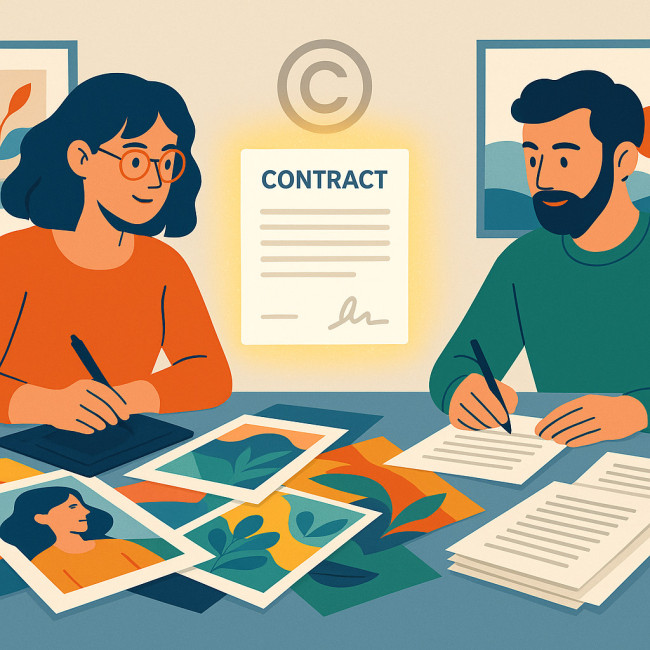Collab contracts 101: protect IP when illustrators team up with writers
When illustration meets prose, sparks fly—and so do questions about ownership, royalties and credit. This guide walks you through the contract clauses that safeguard intellectual property (IP) and keep creative duos focused on great storytelling instead of future lawsuits.
Why IP should top your collaboration agenda

Illustrators and writers each bring unique, protectable assets to a joint project. Art files, character designs, manuscript drafts and even discarded sketches may carry commercial value later—think merchandise, film options or licensing opportunities on platforms such as Artfolio's collaboration marketplace. A clear contract prevents misunderstandings and preserves negotiating power when success strikes.
Key clauses every illustrator-writer contract needs
1. Definition of intellectual property
Spell out exactly what counts as “IP.” Include:
- Pre-existing assets: portfolios, style sheets or previously published texts.
- Jointly created assets: final artwork, layered design files, edited manuscripts.
- Derivative assets: animated trailers, NFTs, limited-edition prints.
2. Ownership model
| Model | Who owns what? | When to choose it | Risk level |
|---|---|---|---|
| Work-for-hire | Commissioner owns 100 % of final IP. | Short ads, one-off spot illos. | Low for commissioner, high for contributor. |
| Joint ownership | Both parties share equal rights to all new IP. | Original graphic novels, long-term series. | Medium—needs exit plan. |
| Licensing | Creator keeps IP, grants usage rights. | Editorial pieces, brand collabs. | Low if license scope is clear. |
3. Royalty and fee structure
Agree on both upfront fees and downstream royalties. Typical splits for self-published picture books hover around 50/50, while traditional publishers pay the illustrator 50 % of the author's rate. Align your deal with market reality by checking the co-writing contract checklist before you sign.
4. Approvals & revision rounds
Limit endless tweaks by locking:
- Number of major revisions (e.g., two full layout passes).
- Minor tweak windows (colour corrections, copy edits).
- Automatic acceptance after X days of silence.
5. Credit & moral rights
Decide early how names appear on covers, metadata and press releases. Credit disputes sink relationships faster than money fights. Inspiration? Review our breakdown of royalty clauses made simple.
6. Termination & dispute resolution
Add a force majeure clause, mediation requirement and a buy-out formula if one party exits. It's insurance you hope never to use.
Calculating payment: combining flat fees and royalties
Here's a common hybrid model for indie projects:
- Illustrator flat fee: 1 000 € to cover sketch, ink and colour stages.
- Writer flat fee: 1 000 € for outline, draft and copy-edit.
- Royalty split: 40 % illustrator / 40 % writer / 20 % marketing kitty.
Document the math in your contract's schedule. Future you will thank present you.
Workflow clauses that save sanity
File formats & delivery
Specify layered PSDs, CMYK TIFF finals and copy in DOCX plus PDF. If an asset isn't listed, it's not required—period.
Timeline & milestones
Use a Gantt-style table that ties payments to visual checkpoints: thumbnails, roughs, finals. This keeps both parties motivated and aligned.
Licensing beyond the book
Successful characters can spawn toys, apparel and digital stickers. A clause that addresses “future media” avoids renegotiation chaos. Learn how to negotiate usage rights before brands call.
Template vs. bespoke contract: which to pick?
Online templates help kick-start discussions, but a media-savvy lawyer tailors clauses to your jurisdiction and project scope. Allocate 5 %–10 % of budget for legal fees—cheap compared to litigation.
Common mistakes (and quick fixes)
- Vague deliverables: add pixel dimensions, word counts and resolution.
- No audit rights: include yearly royalty statements with access to sales data.
- Ignoring moral rights: state whether adaptations need creator approval.
- Using personal email timestamps: switch to shared project management tools for transparent revision history.
- Forgetting exit plan: set a reversion clause after five years of inactivity.
Mini-case study: the webcomic duo

Sara (illustrator) and Leo (writer) launched a weekly webcomic. They drafted a one-page MOU covering ownership, revenue and deadlines. Traffic exploded; a game studio offered an adaptation deal. Because the MOU lacked a licensing clause, negotiations stalled for weeks. After legal review, they upgraded to a full contract—securing equal IP ownership, game royalties and creative approval on character redesigns. Their experience echoes lessons in safeguarding creative credit.
Take the test: are your clauses bullet-proof?
FAQ
- Do we need a contract for a “passion project” with no upfront money?
- Yes. If the project ever makes money or gains attention, lack of paperwork becomes a liability. Even a one-page agreement outlining ownership and exit terms is better than none.
- Who registers copyright—the illustrator, the writer or both?
- Registration depends on ownership model and jurisdiction. Joint owners can file together, or one party can register and list the other as co-author. Agree on costs and timing in the contract.
- Can we publish online first and sign a contract later?
- Publishing before signing weakens your leverage and may assign implied licenses to platforms. Draft the contract before release, even if signatures happen digitally via e-signature.
Ready to draft your collaboration contract?
Protect your creativity today. Compile your project scope, pick an ownership model and book a quick consult with an IP lawyer. The hours you invest now will keep future royalties flowing where they belong—into your shared studio fund.
Next step: Download our free clause checklist (no email required) and start customising your agreement.











